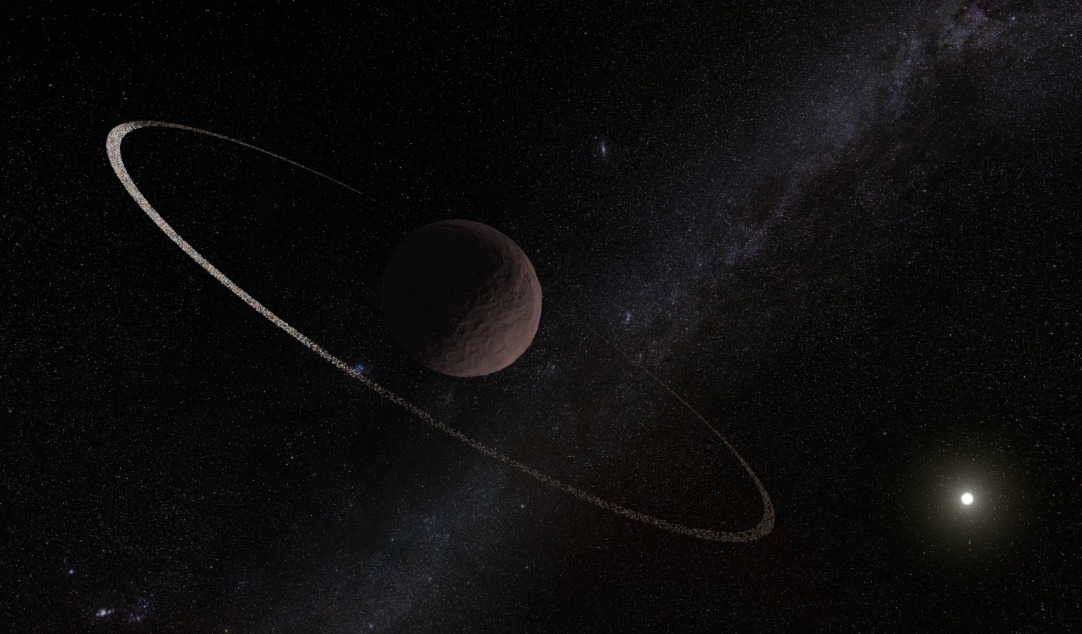The trans-Neptunian object Quaoar shows a ring that questions a theory used since 1850
The Institute of Astrophysics of Andalusia (IAA-CSIC) participates in the discovery of a dense ring in this object that, with a size equivalent to half of Pluto, raises several problems
Until 2013, only rings around the giant planets of the Solar System were known, which changed with the discoveries of rings around the centaur object Chariklo (2013), and the trans-Neptunian object (TNO) Haumea (2017). Now, the finding of a ring around trans-Neptunian Quaoar complicates the scenario, as its ring lies well beyond the Roche limit, which challenges the accepted theory of how far away the dust and ice fragments that form rings should accumulate. The work, published in Nature, is the result of an international collaboration within the European ERC Advanced Grant Lucky Star project.
Quaoar is a large trans-Neptunian object that is about half the size of Pluto and orbits at forty-three astronomical units from the Sun (or forty-three times the distance between the Earth and the Sun). A unique and surprising property of the ring is its large radius which, at 4100 kilometers, corresponds to about 7.4 radii of Quaoar.

This is well beyond the Roche limit, the distance at which, according to the theory developed by Edouard Roche around 1850, the tidal forces of the central body prevent particles from aggregating into a satellite. According to this theory, a collision ring within this limit cannot accrete, while outside this limit particles are expected to aggregate and form a satellite on timescales of only weeks. And so far this was what had been observed: all the dense rings of the four giant planets, as well as the rings of Chariklo and Haumea, are indeed within or close to the Roche limit of their respective bodies. In contrast, Quaoar's ring occupies an orbit where a satellite should have formed.
"When we first saw the possible existence of a ring outside the Roche limit in the excellent data obtained with the Gran Telescopio Canarias, we realized that it could take many years to prove this circumstance conclusively, but we finally succeeded in a few years thanks to a major international effort", says José Luis Ortiz, IAA-CSIC researcher involved in the work.
The discovery of the Quaoar ring triggered numerous numerical studies, and local simulations of self-gravitation were developed. While the collision laws classically used to describe Saturn's rings resulted in fast accretions, which would indeed favor the formation of a satellite in that region, the more elastic collision laws obtained in the laboratory at low temperatures showed the opposite: the post-impact velocities between particles remain high enough to escape each other's attractions and eventually overcome their tendency to accrete. Thus, while Roche's criterion seems sound for explaining how tidal forces disrupt the formation of a satellite to form a ring, the opposite process, the accretion of particles onto a satellite, involves more complex mechanisms that have so far been overlooked.
However, questions remain about this small object. "Curiously, the ring is at a distance from Quaoar in which the particles that form it take just three times as long to go around Quaoar as it takes Quaoar to go around itself. This is a phenomenon that we have observed before in the dwarf planet Haumea and we believe that it also occurs in Chariklo, so there seems to be a common pattern in the formation of dense rings", concludes José Luis Ortiz (IAA-CSIC).
The discovery of rings in such small and distant objects in the Solar System is performed using the stellar occultation method, which consists of observing objects that transit in front of the background stars. The Chariklo and Haumea rings implied that rings must be common among small objects in the outer Solar System, and their search was one of the main goals of the Lucky Star project, led by Bruno Sicardy (Paris Observatory).
The discovery of the Quaoar ring arose from the combination of stellar occultations observed between 2018 and 2021 from a robotic telescope in Namibia (HESS project), the Gran Telescopio Canarias (La Palma), the CHEOPS space telescope (ESA) and Australian amateur stations in the Brisbane region.
B. E. Morgado et al. "A dense ring of the trans-Neptunian object Quaoar outside its Roche Limit". Nature, 09 Feb 2023. https://doi.org/10.1038/s41586-022-05629-6
Instituto de Astrofísica de Andalucía (IAA-CSIC)
Unidad de Divulgación y Comunicación
Silbia López de Lacalle - sll[arroba]iaa.es - 958230676
https://www.iaa.csic.es
https://divulgacion.iaa.csic.es

